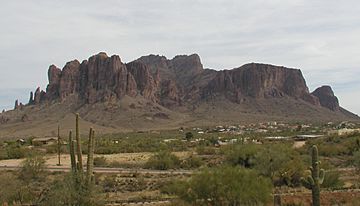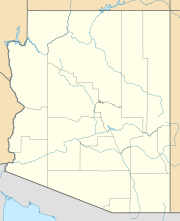Superstition Mountain facts for kids
Quick facts for kids Superstition Mountain |
|
|---|---|

Superstition Mountain as seen from the west over Apache Junction in 2002
|
|
| Highest point | |
| Elevation | 5,059 ft (1,542 m) NAVD 88 |
| Prominence | 1,817 ft (554 m) |
| Naming | |
| Native name | Error {{native name}}: an IETF language tag as parameter {{{1}}} is required (help) |
| Geography | |
| Location | Pinal County, Arizona, U.S. |
| Parent range | Superstition Mountains |
| Topo map | USGS Goldfield |
Superstition Mountain (Yavapai: Wi:kchsawa, O'odham: Gakoḍk) is located immediately east of the Phoenix metropolitan area in Arizona. It anchors the west end of the federally designated Superstition Wilderness Area. The mountain was formed by a series of volcanic eruptions between 20.5 and 18 million years ago. The west face of the mountain is composed of dacite lava and rhyolitic tuff. The overlying tuff was deposited during an eruption which created a collapse caldera bounded by faults. Dome resurgence reactivated these faults, causing uplift of the caldera floor which juxtaposed the softer tuff and more resistant dacite. Differential weathering caused the outer tuff to erode faster, leaving the dacite cliffs exposed and creating the prominent landmark and popular recreation destination visible today.
The mountain, located near Apache Junction and Gold Canyon, Arizona, is easily accessible from U.S. Route 60 and State Route 88. It is a popular three-season (fall, winter, spring) hiking area. Afternoon temperatures from June to September are usually in the range of 100 to 115°F near the mountain. Day hikers often frequent the mountain during cooler months. The Lost Dutchman State Park is located on the western side of the mountain and includes hiking trails to notable formations such as the Praying Hands and the Flatiron. The Peralta Trail, on the southern side of the mountain, traverses Fremont Saddle and descends into the wilderness to the east of the mountain.



